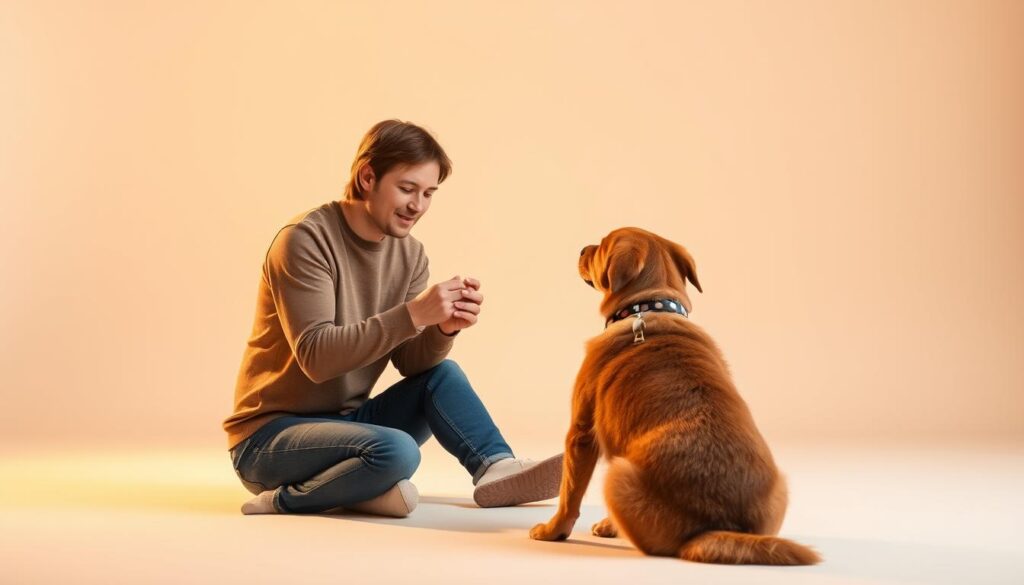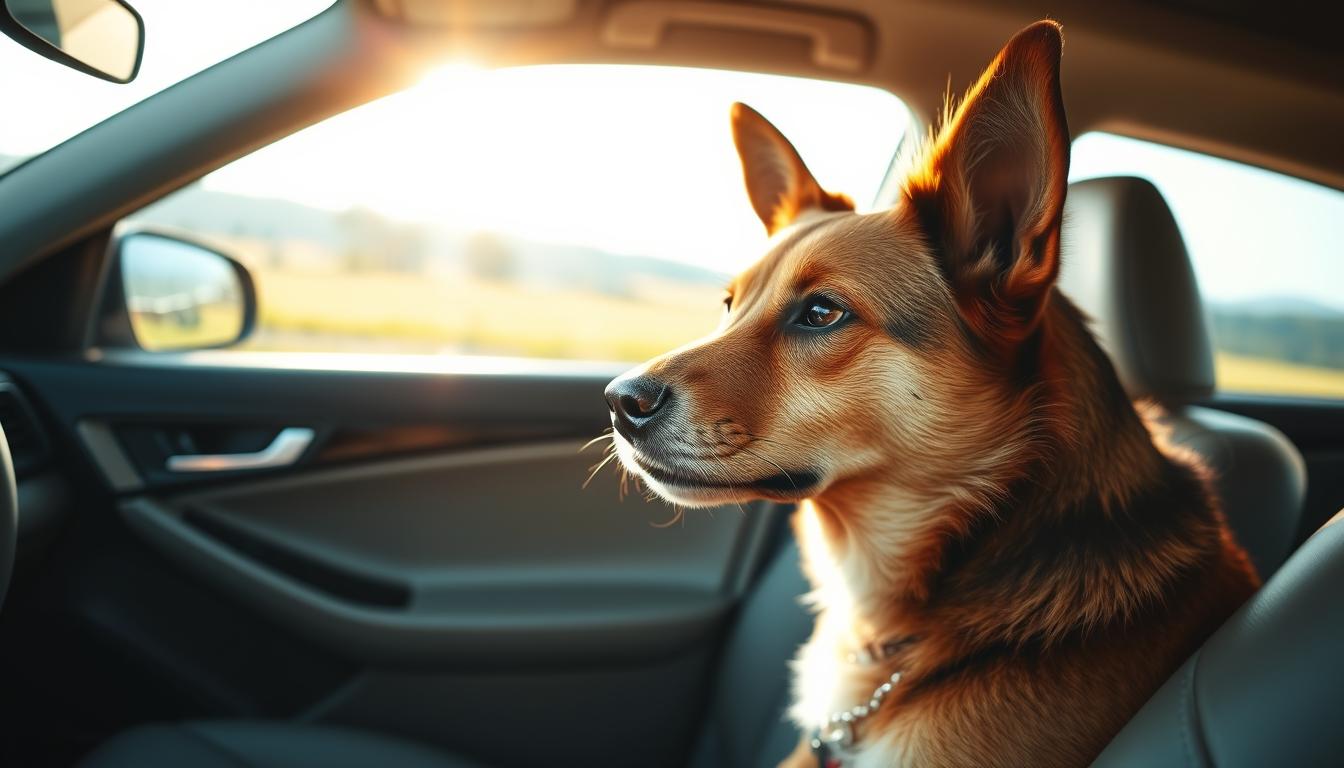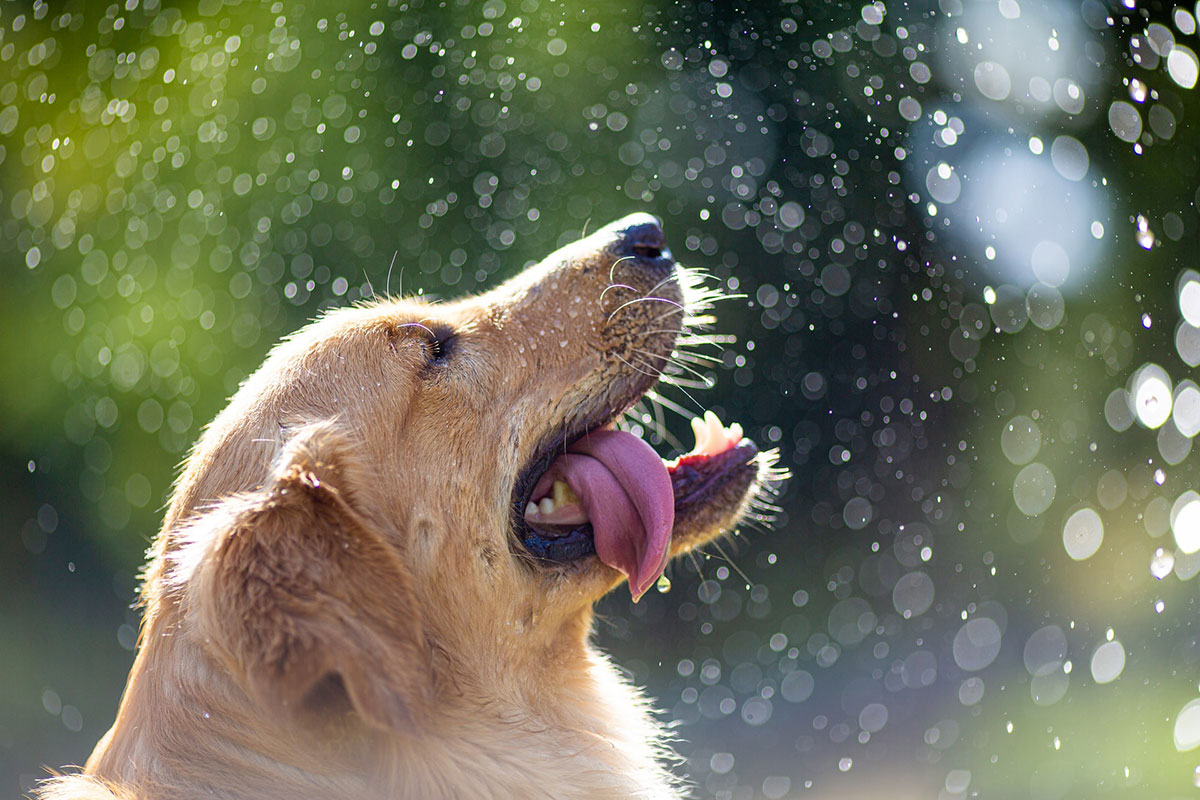Traveling with pets can be stressful, and dog barking during car rides is a big challenge. At BarkingBatty.com, we get it. We’re here to help you manage your dog’s barking while on the move.
Dogs bark for many reasons, like anxiety, excitement, or feeling uncomfortable. It’s important to solve this problem. It makes the journey safer and more enjoyable for both the dog and the owner.
Using the right dog training and calming dogs methods can help a lot. In this article, we’ll look at why dogs bark in cars. We’ll also share practical tips to make your trips with your pet better.
Why Dogs Bark During Car Rides
It’s important to know why dogs bark when they’re in cars. They bark for many reasons, mostly because of how they feel or what they see around them.
One big reason is anxiety. Dogs might feel scared or uneasy in the car. This can make them bark.
Another reason is barrier aggression. Dogs bark when they see people or animals outside. They feel like they need to protect their space or the people inside.
Excitement is another reason. Some dogs bark because they’re thrilled to be on the move or seeing new sights.
To help your dog during car rides, you need to figure out why they bark. Here are some common reasons and ways to fix them:
- Anxiety or Fear: Help your dog get used to the car.
- Barrier Aggression: Keep your dog from seeing outside or distract them.
- Excitement: Play with your dog before you leave to calm them down.
Knowing why your dog barks in the car helps you make their ride better. It makes traveling more fun for both of you.
Understanding Your Dog’s Specific Triggers
To solve your dog’s barking problem while driving, you need to know what causes it. Dog triggers can be different for each dog. They might bark due to anxiety, excitement, or even loud noises.
One good way to find out what triggers your dog’s barking is to watch their behavior closely. By observing your dog during car rides, you can figure out why they bark.
Using Video to Analyze Behavior
Recording your dog’s behavior on video is a helpful tool. It lets you see their reactions and spot patterns. Video analysis helps you see exactly when and why your dog barks.
Watching the video closely can help you understand why your dog barks. It might be because they’re anxious, too excited, or something else. This knowledge helps you find the right way to stop the barking.
Knowing what makes your dog bark and using video analysis can help you find a better solution. This makes car rides more fun for both you and your dog.
Pre-Travel Preparation Techniques
To stop your dog from barking during car rides, start with thoroughpre-travel preparation techniques. Effective preparation can make a big difference in your dog’s behavior during travel.
One of the keypre-travel preparationsteps is to ensure your dog is well-exercised before the journey. A tired dog is generally calmer and less prone to barking. For more tips on reducing barking, you can visithttps://barkingbatty.com/how-to-stop-your-dog-from-barking/.
Another crucial aspect ispositive reinforcement training. Reward your dog for calm behavior, which can help reinforce good habits during travel. This training should be part of your daily routine leading up to the trip.
Getting your dog accustomed to the car’s environment is also important. Start by letting your dog explore the car while it’s stationary, then gradually introduce short drives. Thisgradual desensitizationcan significantly reduce travel anxiety and barking.
By incorporating thesetravel tipsand techniques into your pre-travel routine, you can help ensure a more peaceful journey for both you and your dog.
Gradual Desensitization Training Methods
Desensitization training helps your dog feel less stressed and bark less in cars. It involves slowly exposing your dog to car rides. Start with a level that doesn’t upset them.
Start small to succeed in gradual desensitization. For example, if your dog barks at the car, begin by standing near it while it’s parked. Reward them for staying calm.

Using reward systems is crucial. Treats, praise, and affection for calm behavior teach your dog that car rides are good. This positive association helps a lot.
Being consistent is important. Make sure everyone rewards your dog the same way. Give rewards right after the good behavior to make the connection clear.
Handling Setbacks in Training
Setbacks happen in training. If your dog gets stressed or barks more, stay calm and patient. Figure out what went wrong and change your plan.
Lower the intensity or slow down if needed. Always move at your dog’s pace. Their comfort is the top priority.
Stop Your Dog From Barking During Car Rides and Travel: Effective Commands
Effective commands can really help control your dog’s barking during car rides. Teaching your dog specific commands can distract them from what makes them bark. This improves their behavior on trips.
The “quiet” command is very useful. Start by having your dog bark, then say “quiet” and hold a treat in front of their nose. When they stop barking, give them the treat and praise. This teaches them that being quiet is rewarded.
The “look” or “watch me” command also works well. Hold a treat near your face and say the command. When your dog looks at you, reward them with the treat and praise. This command is great for car rides when your dog might bark at other cars or people.
Consistency is key when training your dog. Make sure everyone uses the same commands and rewards good behavior. Regular practice, both in and out of the car, will help these commands stick and reduce barking.
Using commands like “settle” or “relax” can also calm your dog during car rides. Teach these by creating a calm environment and rewarding your dog for staying calm. With these commands and a calm, assertive tone, you can greatly reduce your dog’s barking during travel.
By using these effective commands and staying consistent, car rides will be more fun for both you and your dog.
Calming Products and Tools
There are many calming products and tools to help reduce your dog’s barking in the car. They can make a big difference.
Pheromone diffusers or sprays are popular dog calming tools. They mimic the calming pheromones mother dogs use to soothe their puppies. This helps lower your dog’s stress and anxiety while traveling.

A calming vest or wrap is another great travel accessory. These garments apply gentle pressure, like swaddling an infant. They’re great for dogs that get anxious or stressed in the car.
Calming treats and supplements are also used to reduce barking. They often have natural ingredients like melatonin or chamomile. But, always talk to a vet before giving your dog new supplements to make sure they’re safe.
There are also calming tools that work with training to cut down on barking. For instance, calming music or white noise can make the car ride more relaxing for your dog.
Using these calming products and tools can greatly reduce your dog’s stress and barking. This makes car rides better for both you and your pet.
Safe Restraint Systems That Reduce Barking
Safe restraint systems are crucial for your dog’s safety and help cut down on barking in cars. Dogs can get too excited or anxious when they’re free to roam. This can lead to a lot of barking. Using the right restraint can greatly lessen this problem.
There are many safe restraint systems for dogs. Crates are a favorite because they offer a safe, enclosed area. This can help calm your dog. Make sure the crate is big enough for your dog to move around and lie down comfortably.
Dog seat belts or harnesses are another good choice. They let your dog move a bit but keep them safe. They hook into the car’s seat belt system, stopping your dog from moving around.
- Crates: Provide a secure, enclosed space.
- Dog Seat Belts/Harnesses: Allow for some movement while keeping your dog secure.
- Barrier Systems: Create a separation between the dog and the front seats.
Choosing the right restraint system keeps your dog safe and reduces barking. This is because it helps prevent anxiety and overstimulation during car rides.
Natural Remedies and Professional Help
For dog owners, finding ways to calm pets in cars is crucial. Barking during travel can upset both dogs and their owners. It often needs a mix of solutions.
Natural remedies can help a lot. Pheromone diffusers, like Adaptil, mimic a mother dog’s calming scent. Calming treats with chamomile or lavender and soothing collars are also good. Dr. Karen Overall, a top animal behaviorist, says these aids can greatly reduce a dog’s stress in cars.
But, some dogs might need more help. That’s where professional dog training comes in. A trainer can find out why your dog barks and create a special training plan.
Working with a Professional Trainer
Getting help from a professional trainer can be very helpful. They teach you how to make your dog comfortable in the car. They also teach you commands to calm your dog while traveling. Victoria Stilwell, a certified trainer, says patience, consistency, and positive reinforcement are key.
Using natural remedies and professional training together can greatly reduce your dog’s car barking. This makes trips more fun for both you and your pet.
- Explore various natural calming products.
- Consider consulting with a professional dog trainer.
- Develop a customized training plan tailored to your dog’s needs.
Addressing Specific Travel Scenarios
Understanding why dogs bark during travel is key. Different situations, like car rides, air travel, or vet visits, can stress them out. This stress often leads to barking.
Car rides can make dogs bark from excitement, anxiety, or seeing other animals. To help, gradual exposure to the car and positive reinforcement are good. Start by letting the car sit still, then move it slowly.
Air travel is tough for dogs. They may bark because of the new sights and sounds. Acclimating your dog to their carrier and using calming aids can help.
Visits to the vet can also cause barking. Make the carrier comfy and use calming products to help.
- Keep your dog calm with familiar comforts like favorite toys or blankets.
- Use positive reinforcement training to associate travel with positive experiences.
- Consider professional help for severe cases of travel anxiety.
By understanding and addressing travel scenarios that cause barking, owners can make travel better for dogs. As one expert says, “Preparation and patience are key to reducing your dog’s stress during travel.”
“The goal is to make your dog feel safe and secure in various travel scenarios.”
Conclusion: Creating Positive Travel Experiences for Your Dog
It’s important to make travel fun for your dog. Knowing why they bark in cars helps a lot. It makes their trips better.
Getting them ready for travel, teaching them calm commands, and using calming aids helps a lot. These steps can make your dog feel safer and more relaxed on car rides.
Keeping your dog safe and happy on trips is key. By using the right strategies, you both can enjoy the journey more. This strengthens your bond and makes future trips better.
By focusing on your dog’s needs and calming their barking, you make trips more enjoyable. This leads to happier, healthier dogs and better travel experiences for everyone.






